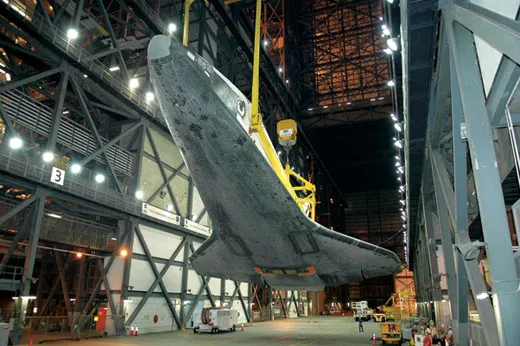Shuttle Tiles
Why the space shuttle can withstand reentry temperatures up to 2,300 degrees.
IN 1981, DEVELOPMENT OF INSULATING TILES CONTRIBUTED TO DELAYS IN THE FIRST SHUTTLE LAUNCH, and last year, the difficulty of repairing tiles raised the world’s anxiety about the shuttle’s most recent mission. Though both flights ultimately went smoothly, the tiles have become the shuttle’s most famous components.
Each shuttle is covered by more than 24,000 of the six- by six-inch blocks. Most of the tiles are made of silica fibers, which are produced from high-grade sand. Silica is an excellent insulator because it transports heat slowly. When the outer portion of a tile gets hot, the heat takes a long time to work its way down through the rest of the tile to the shuttle’s skin. The tiles keep the orbiter’s aluminum skin at 350 degrees or less.
The silica fibers are mixed with water and chemicals, and the mixture is poured into molds, which are zapped in microwave ovens at 2,350 degrees to fuse the silica fibers.
Tiles are too brittle to attach to the orbiter directly. The shuttle’s skin contracts slightly while in orbit, then expands during reentry. In addition, the stresses of launch and reentry cause the skin to flex and bend. Such motions could easily crack the tiles or shake them off. To keep them in place, workers glue the tiles to flexible felt-like pads, then glue the pads to the orbiter.
The primary tiles used are given one of two coatings. The tiles exposed to reentry temperatures of up to 2,300 degrees Fahrenheit, such as those on portions of the belly, are given a protective coating of black glass. Black tiles work by reflecting about 90 percent of the heat they’re exposed to back into the atmosphere, while the tiles’ interior absorbs the rest. The tiles’ interiors radiate absorbed heat so slowly that after landing, the tiles take hours to cool.
On parts of the shuttle’s upper fuselage, which are exposed to much lower temperatures, the tiles are covered with a whitewash of silica compounds and aluminum oxide; these tiles protect against temperatures of up to 1,200 degrees.
NASA also uses two other types of tiles; denser and coated with stronger material, they provide extra protection to areas that are particularly vulnerable to strikes from space debris.
About 30 to 100 tiles are replaced before each mission. Some were lost or damaged during flight, while others were removed because workers needed to get to structures below them. When a new tile is needed, it is fabricated and installed at Florida’s Kennedy Space Center. A computer-controlled machine cuts the tile to fit, either from stored patterns or from measurements of the actual space on the orbiter. In thickness, most tiles vary from about half an inch to four inches, depending on how much heat resistance is necessary. Because no two tiles are exactly the same size, “each one is custom-made,” says Katherine Laufenberg, associate chief engineer for ground operations at United Space Alliance, the contractor that prepares the orbiters for flight. Installers leave small gaps between the tiles to prevent damage when the orbiter’s aluminum skin moves. Sometimes, though, the gaps are too wide and are plugged with fillers.
Until recently, damaged tiles could be repaired only after the shuttle returned to Earth. That is about to change. Although the 2003 Columbia accident was caused by debris shed from a reinforced carbon-carbon panel on the wing’s leading edge, the accident investigating board recommended, among other things, that NASA give the astronauts the capacity to perform “on orbit” repairs to the shuttle’s exterior, including its tiles. The agency has developed two solutions.
The first is called an emittance wash—a material that looks like shoe polish and consists of silicon carbide fibers mixed with the glue that bonds the tiles to the orbiter. Ground tests indicate that the material can increase the amount of heat that a damaged tile radiates by about 70 to 160 degrees. An astronaut on a spacewalk would dab the wash on a damaged tile with a tool that looks like a shoe polish applicator.
Last summer, astronauts on the STS-114 mission tested the system on a tile during a spacewalk. “The crew was able to use the tool without incident or concern,” says Steve Poulos, NASA’s former manager of the shuttle’s thermal systems.
Engineers are completing ground tests of how the wash would perform with different types of tile damage. “It’s not a panacea,” Poulos says, but the wash can make a marginal tile safer.
For bigger dings, astronauts may bolt on a 12- by 25-inch plate of carbon-silicon carbide composite. The plates are just .03 inch thick but are expected to provide the same thermal protections the original tiles did.
Currently, NASA plans to include both the plates and the emittance wash on the next shuttle mission: a Discovery flight, now scheduled for May. Says Poulos: “I’m very optimistic that by the end of this year, we’ll have our repair capabilities done.”
